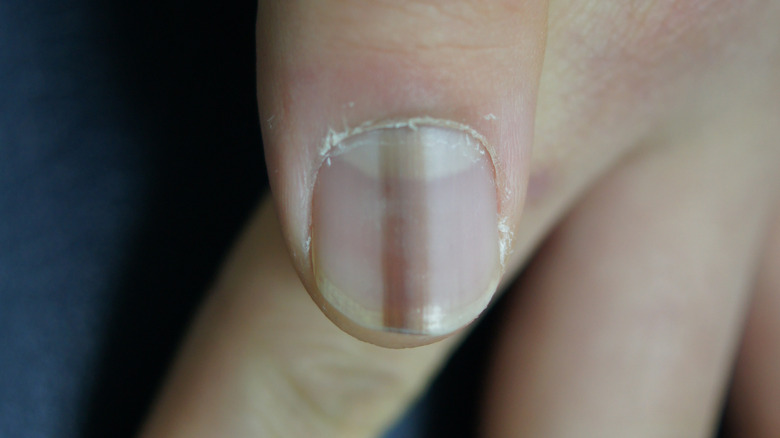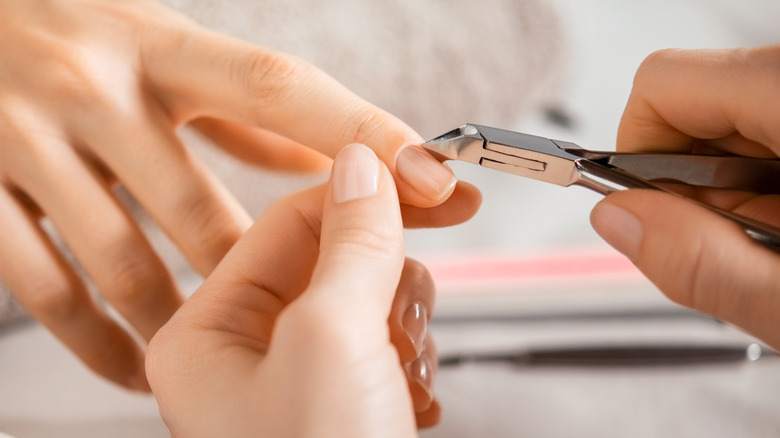Experts Explain Why You May Be Getting Black Lines On Your Nails
Nail care often takes a backseat to skincare or hair care. Nevertheless, it's important for both aesthetic and health reasons. Nails keep the tips of the fingers and toes from harm and prevent germs and dirt from crawling into the body. Healthy nails look smooth, spot-free, and consistent in color. Dirty nails can open the door to fungal infections and inflammation, making the nails look brittle, and the fingers can become swollen with pus. Unfortunately, many of us only pay more attention to our nail health when they show abnormal changes.
One nail issue that many people encounter is black lines. These dark streaks can develop in one nail or multiple nails, affecting their appearance and leaving people concerned. To help explain why you're seeing these black lines on your nails and whether they should be a cause for concern, Glam spoke to Christine Kingsley, advanced practice registered nurse (APRN) and health and wellness director of the Lung Institute, and Parabell Beauty's nail content creator Ashley Ann for more insight. Here's what we learned.
Possible causes of black lines on your nails
Changes in nail color can have a variety of causes. Some are benign, while others may call for medical attention. According to Christine Kingsley, black lines on the nails are typically caused by "minor trauma or injury to the nail bed," such as "hitting your finger on a hard surface or as a result of repetitive stress on the nail." In this case, they will gradually fade and don't require professional treatment. However, black or brown lines on the nails can also be indicative of more serious underlying conditions such as melanoma — a type of skin cancer. In rare cases, they may also be signs of "a systemic disease such as lupus or endocarditis," adds Kingsley.
While these are possible causes for dark-colored discoloration of the nail plate, a lesser-known cause is melanonychia, a benign condition where a higher concentration of pigment is deposited into the skin. "When you have more melanin in your skin, some of the melanin can deposit into the nails, which causes these brown lines," Ashley Ann explains.
Both Kingsley and Ann agree that any recurring or abnormal changes in the nails should get checked by a medical specialist for an accurate diagnosis and timely treatment. For instance, if melanoma is the cause of inconsistent nail coloring, it should be treated promptly. The condition can become more dangerous and difficult to treat once it has progressed further into the skin or other parts of the body.
Tips for practicing nail hygiene
To keep your nails in tip-top shape, make a point of keeping them dry and clean. It's easier for your nails to split and for bacteria and fungi to get in when they are exposed to water for extended periods. Always wear rubber gloves when washing dishes, doing laundry, or using harsh chemicals.
The American Academy of Dermatology also advises against biting fingernails or removing the cuticles, which can injure the tissue that helps nails grow and cause damage to the nails. To reduce the risk of trauma and injury to the nail beds, take care to trim your nails regularly. When you cut your nails, use sharp nail scissors or clippers, cut them straight across, and curve your nails at the tips. If you're having an ingrown nail, visit a healthcare provider for help instead of digging and lifting the ingrowing edge on your own. To keep your nails moist and healthy, moisturize them with cuticle creams or petroleum jelly every day. Whenever you get a gel manicure, lather your hands with sunscreen to protect them against potential damage from prolonged exposure to UV nail lamps. If your nails are brittle and prone to breakage, applying a nail hardener to your nails once a week can make them stronger and more resistant to splitting.


